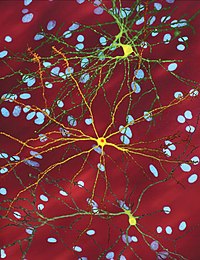
Photo from wikipedia
Huntington's disease is a devastating neurodegenerative genetic disorder that causes progressive motor dysfunction, emotional disturbances, and cognitive impairment. Unfortunately, there is no treatment to cure or slow the progression of… Click to show full abstract
Huntington's disease is a devastating neurodegenerative genetic disorder that causes progressive motor dysfunction, emotional disturbances, and cognitive impairment. Unfortunately, there is no treatment to cure or slow the progression of the disease. Neuroinflammation is one hallmark of Huntington's disease, and modulation of neuroinflammation has been suggested as a potential target for therapeutic intervention. The relationship between neuroinflammation markers and the disease pathology is still poorly understood. To improve our understanding of neuroinflammation in Huntington's disease, we measured translocator protein (TSPO) expression using 11C-PBR28 and simultaneous PET/MRI. Standardized-uptake-value ratios, normalized by whole brain uptake, were calculated for data acquired 60-90 min after radiotracer administration. We identified distinct patterns of regional neuroinflammation (as defined by TSPO overexpression relative to a control group) in the basal ganglia of Huntington's disease patients. These patterns were observed at the individual level in all patients, with region of interest analysis confirming significant differences between patients and the control group in the putamen and the pallidum. Additionally, we observed further distinct regional and subregional signatures, which may provide insights into phenotypical variability. For example, in certain Huntington's disease patients, we observed in vivo elevation of the level of TSPO binding in subnuclei in the thalamus and brainstem that have been previously associated with visual function, motor function, and motor coordination. Our main result is an objective score, based solely on 11C-PBR28 measurements, that correlates well with measurements of brain atrophy. We conclude that PET/MR imaging using 11C-PBR28 provides a high signal-to-background ratio and has the potential to be used to assess Huntington's disease progression. Our results suggest 11C-PBR28 might prove useful in clinical trials evaluating therapies targeting neuroinflammation.
Journal Title: ACS chemical neuroscience
Year Published: 2018
Link to full text (if available)
Share on Social Media: Sign Up to like & get
recommendations!